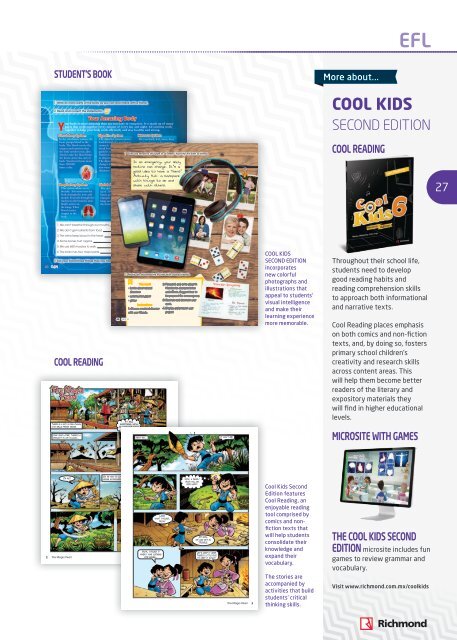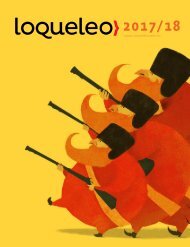CATALOG_RICMOND_2017_INT-op
You also want an ePaper? Increase the reach of your titles
YUMPU automatically turns print PDFs into web optimized ePapers that Google loves.
EFL<br />
Student’s Book<br />
More about...<br />
1 Write as many parts of the body as you can and check with a friend.<br />
6<br />
2 Read and correct the statements.<br />
Your body is more amazing than any machine or computer. It is made up of many<br />
parts that work together every minute of every day and night. All systems work<br />
together to help your body work efficiently and stay healthy and strong.<br />
COOL KIDS<br />
SECOND EDITION<br />
In the circulatory system, the<br />
heart pumps blood to the<br />
body. The blood carries the<br />
oxygen and nutrients that<br />
the body needs to stay alive.<br />
Arteries take the blood from<br />
the heart, and veins carry it<br />
back. Your heart beats more<br />
than 100,000<br />
times a day.<br />
This system allows us to<br />
breathe. Air comes into the<br />
body through the nose and<br />
mouth. It travels through the<br />
trachea to the bronchi, and<br />
finally arrives in<br />
the lungs. Then<br />
blood carries<br />
oxygen to the<br />
body.<br />
The digestive system moves We can think, feel, move, hear,<br />
food through the es<strong>op</strong>hagus, and see thanks to the nervous<br />
stomach, and intestines. They system. It includes the brain,<br />
break food down into tiny spinal cord, and nerves. The<br />
particles called nutrients. brain has three major parts that<br />
Nutrients use blood to 1 travel Discuss what<br />
control<br />
to<br />
thinking,<br />
include<br />
speech,<br />
in a Teens’<br />
vision,<br />
Activity Kit with a friend.<br />
to all parts of the body. and physical coordination, and<br />
The digestive system In an the respiratory, emergency, circulatory, your and daily<br />
changes the food<br />
digestive systems. The<br />
into waste and routine brain sends can signals change. to It’s a<br />
eliminates it.<br />
good the idea rest of the to body have a Teens’<br />
using the spinal cord.<br />
Activity Kit: a backpack<br />
with things to do and<br />
share with others.<br />
The skeletal system is made Muscles are elastic fibers<br />
up of 206 bones. Some that help your body to move.<br />
bones protect organs; for There are 650 muscles in<br />
example, the ribs cover the your body. When we walk,<br />
lungs and the skull protects we use about 200<br />
the brain.<br />
muscles.<br />
Cool rEAding<br />
27<br />
1. We can’t breathe through our mouths.<br />
2. We don’t get nutrients from food.<br />
3. The veins keep blood in the heart.<br />
4. Some bones hurt organs.<br />
5. We use 650 muscles to walk.<br />
6. The brain has four major parts.<br />
3 Tell your friend three things that you have learned.<br />
10 Unit 1<br />
2 Make an Informative Poster with some friends.<br />
You need 2. Research and write about it.<br />
• books about natural Mention its characteristics<br />
disasters<br />
and effects. Suggest how to<br />
• construction paper<br />
be prepared for an emergency.<br />
• glitter<br />
3. Illustrate and decorate your<br />
Instructions work.<br />
1. Choose a natural disaster 4. Display and present your<br />
with your friends.<br />
project.<br />
48 Unit 4<br />
Cool rEAding<br />
If I sell<br />
There is a boy in Sih Chuan<br />
everything, we’ll<br />
who sells fresh grass.<br />
buy rice for today<br />
and tomorrow.<br />
One year later, there’s a<br />
drought in his village...<br />
Next day...<br />
It can’t be!<br />
Cool Kids<br />
SecoND EDITIon<br />
incorporates<br />
new colorful<br />
photographs and<br />
illustrations that<br />
appeal to students’<br />
visual intelligence<br />
and make their<br />
learning experience<br />
more memorable.<br />
Throughout their school life,<br />
students need to devel<strong>op</strong><br />
good reading habits and<br />
reading comprehension skills<br />
to approach both informational<br />
and narrative texts.<br />
Cool Reading places emphasis<br />
on both comics and non-fiction<br />
texts, and, by doing so, fosters<br />
primary school children’s<br />
creativity and research skills<br />
across content areas. This<br />
will help them become better<br />
readers of the literary and<br />
expository materials they<br />
will find in higher educational<br />
levels.<br />
Microsite with GAMEs<br />
Oh no!<br />
2 The Magic Pearl<br />
So he has to look for the<br />
grass somewhere else.<br />
Look<br />
what I found,<br />
Mom!<br />
Mom, I found it<br />
when I was looking<br />
for grass…<br />
Wow, a pearl!<br />
Mom will be<br />
very happy.<br />
My son,<br />
we can get in<br />
trouble.<br />
Let’s keep it here.<br />
There’s little rice<br />
to keep it intact.<br />
The Magic Pearl<br />
3<br />
Cool Kids Second<br />
Edition features<br />
Cool Reading, an<br />
enjoyable reading<br />
tool comprised by<br />
comics and nonfiction<br />
texts that<br />
will help students<br />
consolidate their<br />
knowledge and<br />
expand their<br />
vocabulary.<br />
The stories are<br />
accompanied by<br />
activities that build<br />
students’ critical<br />
thinking skills.<br />
tHE Cool Kids sECond<br />
Edition microsite includes fun<br />
games to review grammar and<br />
vocabulary.<br />
Visit www.richmond.com.mx/coolkids




